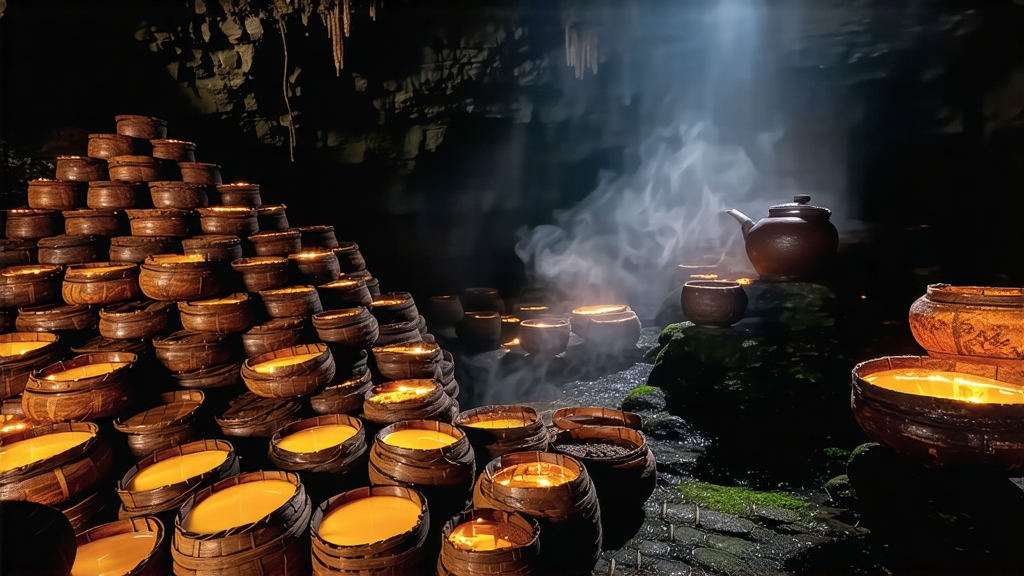
Tucked away in the humid mountains of southern China’s Guangxi Zhuang Autonomous Region, Liu Bao tea has spent four centuries quietly perfecting the art of controlled aging. To the casual eye it is merely another dark, compressed brick; to the initiated it is a living archive of microbes, climate and human patience. While Pu-erh has become the global shorthand for “aged Chinese tea,” Liu Bao is its subtler, earlier ancestor—proof that the Chinese understood post-fermentation long before microbiology had a name.
History: From Border Currency to Imperial Tribute
The story begins during the late Ming dynasty (1368-1644), when the Qing government needed reliable horses from the mountain tribes of Guangxi and neighbouring Yunnan. Tea was the agreed currency. Compressed into 500 g bamboo baskets, Liu Bao travelled the “Tea-Horse Road” north-westward, its flavour evolving with every humid mile. By the Qing Qianlong era (1736-1795) the tea had impressed the imperial court so deeply that it was listed among the “Eight Famous Teas of Guangxi” and shipped to Beijing via the Xunjiang River and the Grand Canal. In 1886 a German missionary stationed in Wuzhou sent a basket back to Berlin; the surviving leaves, now in the Museum für Asiatische Kunst, still release a faint camphor scent when warmed, testimony to the tea’s legendary shelf life.
Terroir: Where Rivers Meet Mist
Liu Bao is produced in a 300 km² micro-zone where the Lian Shan and Da Wu Shan ranges funnel warm, moist air from the Xi Jiang river system. The native cultivar—Camellia sinensis var. sinensis f. pubilimba—bears leaves that are slightly broader and more pubescent than those of Yunnan’s big-leaf varietal. The extra down traps moisture, encouraging the indigenous moulds and yeasts that will later drive fermentation. Soil is lateritic, rich in iron and potassium, giving the finished tea its characteristic metallic sweetness on the back-palate.
Harvest Calendar: Picking for Tomorrow’s Microbes
Plucking follows a strict three-window schedule:
- Pre-Qingming (late March) – one bud plus one leaf, destined for the highest grade “Song Zhen” (Pine Needle) Liu Bao.
- Grain Rain (late April) – one bud plus two leaves, the workhorse material for commercial grades.
- Li Xia (early May) – one bud plus three leaves, reserved for post-fermentation bricks that will age for decades.
Leaves are picked between 9 a.m. and noon, when surface moisture has evaporated but before the afternoon heat converts too much polyphenol into astringent catechins.
Craft: The Six Acts of Transformation
- Sha Qing (Kill-Green) – 3 minutes in a 200 °C bamboo drum roaster arrests oxidation yet keeps enzymatic edges for later microbial use.
- Rolling – A 40-minute ride in a cedar-wood roller bruises cells without rupturing them, releasing amino acids that will feed Eurotium cristatum, the prized “golden flower” mould.
- Sun-Drying – Leaves are spread on hemp cloth atop granite slabs; UV-rich mountain sunlight drops moisture to 10 % within four hours, creating a faint hay aroma that connoisseurs call “mountain sunshine.”
- Wet-Piling (Wo Dui) – Invented here in 1858, a full 22 years before Yunnan adopted the technique for ripe Pu-erh. Leaves are misted to 35 % moisture, piled 70 cm high under jute tarpaulins, and turned every 48 hours. Internal temperature is not allowed to exceed 65 °C; thermophilic bacteria generate a sweet, betel-nut note within 25–30 days.
- Compression – Traditionally 50 kg of fermented leaf are steamed for 90 seconds, then rammed into cylindrical bamboo baskets lined with wild banana leaf. A team of three men compresses the bundle using a levered log, producing the signature “big basket” (Da Lou) of 37 cm diameter.
- Cave Aging – Baskets are moved to natural limestone caves outside Liubao town where relative humidity hovers at 85 % and temperature at 22 °C year-round. Over decades, slow respiration of the bamboo and micro-oxidation through its pores